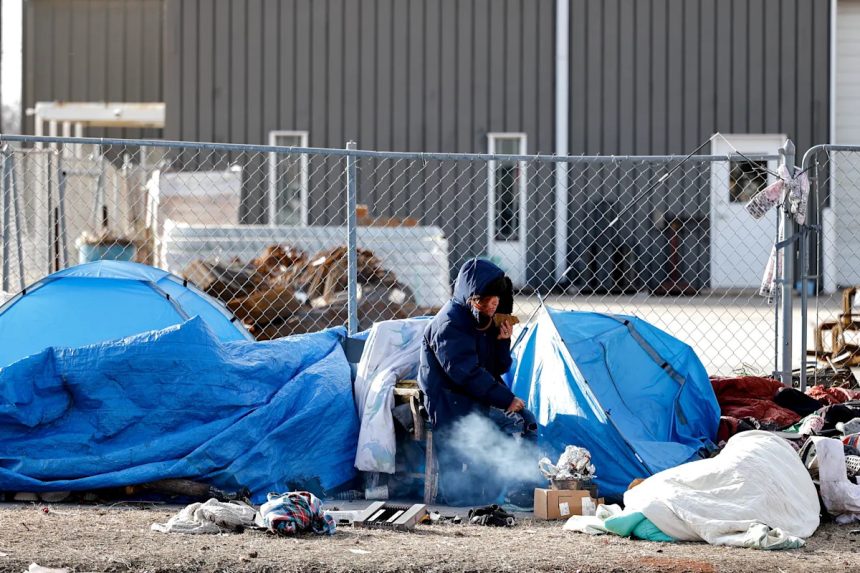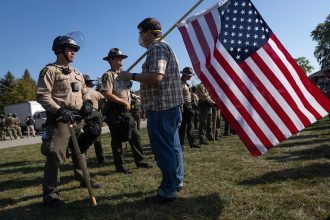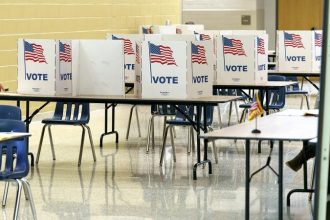State troopers cleared 11 homeless encampments in Oklahoma City in a surprise round of sweeps Monday, Oct. 27, and say more could be on the way.
The operation marked the expansion of Gov. Kevin Stitt’s campaign to remove unhoused people and their belongings from state-owned land. For the first time, troopers targeted the capital city.
The governor’s “Operation SAFE” campaign started in Tulsa and wasn’t aimed for Oklahoma City until business leaders asked Stitt to take action, said Abegail Cave, a spokesperson for the governor. She said the Oct. 27 operation came together after about two weeks of planning and involved coordinating with city officials.
“People asked, and people were willing to step up and help,” Cave said. “We were inclined to do that.”
Cave said troopers cleared out the bridges under Interstate 235 on NE 23rd Street and Reno Avenue on Monday in Oklahoma City. They also cleared out Interstate 40 from Meridian Avenue to MacArthur Boulevard.
More: Gov. Stitt authorizes Operation SAFE to clear homeless encampments in Oklahoma City
Holly Foxtch warms up by the fire Jan. 13, 2024, near the Homeless Alliance day shelter in Oklahoma City. Homelessness has become an issue in Oklahoma City for which officials have tried to find solutions. Gov. Kevin Stitt’s campaign to remove unhoused people and their belongings from state-owned land has now moved to Oklahoma City. For the first time, troopers targeted the capital city.
Troopers helped 12 people who had been living at the encampments get services through the city’s Key to Home partnership that helps connect people with shelter and care, said Oklahoma Highway Patrol Lt. Mark Southall.
Southall said he did not know how many people in total were forced to find somewhere else to live.
At a news conference on Tuesday, Oct. 28, Stitt described the effort as a success, though he acknowledged he was not “solving homelessness.”
“But I am going to enforce the law, and I’m going to make sure Oklahoma’s clean, and we’re going to get people the help that they need,” Stitt, a Republican, said. “We’re not going to let people — it’s not compassionate to leave people underneath an overpass sleeping.”
More: Operation SAFE expands into OKC. How does it differ from Tulsa? How many housed? What we know
The effort drew criticism from Democratic state lawmakers who represent parts of Oklahoma City, including House Minority Leader Cyndi Munson, who is running for governor in 2026. She said there was no evidence that past sweeps in Tulsa improved outcomes for people experiencing homelessness.
“Initiating this now in Oklahoma City is extremely irresponsible, does not solve the problem of homelessness, and only ends up costing taxpayers,” she said.
Oklahoma City Mayor David Holt told The Oklahoman in a text message Monday that state officials had reached out to the city ahead of the sweeps and “requested collaboration.”
“State-owned property is obviously a very limited subset of Oklahoma City’s land mass, so the work of Key to Home will continue long past today,” said Holt, a Republican.
Jamie Caves, the homeless strategy implementation manager for Key to Home, said the program was already in place to help people when state officials reached out about the planned sweeps.
“We’ve worked hard to coordinate efforts more effectively and create a streamlined pathway to restoration for our neighbors who are sleeping outside,” Caves said.
Southall said troopers may conduct future sweeps in Oklahoma City but are waiting for workers with Key to Home to reach out to the people living in those spaces. He said he wasn’t sure when that would happen and wasn’t able to provide a list of exact locations of encampments that would be cleared in the future.
More: Hundreds of Tulsans were displaced during Operation SAFE, adding barriers to getting help
Operation SAFE takes different path in OKC from Tulsa

Tents belonging to people living unsheltered in Oklahoma City are pictured Jan. 9, 2024. According to an annual survey conducted that same month, 433 people were living on the streets at that time. The count stayed roughly the same in 2025. Gov. Kevin Stitt, in a news conference on Oct. 28 about his “Operation SAFE” sweeps coming to the capital city, said “We’re not going to let people — it’s not compassionate to leave people underneath an overpass sleeping.”
Stitt launched his push to clear homeless encampments in September, branding it as Operation SAFE. It came after President Donald Trump issued similar directives targeting Washington, DC, and warned mayors of other Democratic-led cities that they could be next.
The implementation of Operation SAFE in Oklahoma’s two largest cities has had noticeable differences.
Tulsa’s Democratic mayor, Monroe Nichols, has said the governor’s office kept the city in the dark about the sweeps and criticized the removals as failing to address the root causes of homelessness. The camp-clearing effort lasted 12 days and ended Sept. 17.
Stitt said the state was aiming “to restore order and safety” in Tulsa by “clearing homeless encampments, trash, and criminal activity from state-owned property inside the city.”
The governor’s announcement about the sweeps in Oklahoma City made no mention of restoring order or clearing criminal activity.
Holt said he was grateful state officials coordinated their efforts with the city.
“The state collaborating with us was a good move, if for no other reason than it took advantage of an existing, proven program,” said Holt, referring to Key to Home.
“This approach of utilizing Key to Home on state property not only accomplishes the property owner’s goal of clearing their property, it also helps to reduce homelessness for the entire community, which should be the real goal,” Holt said.
The nonprofit has been working with the capital city since 2023, when several groups formed a partnership to reduce unsheltered homelessness. The program is on track to meet its goal of housing 500 people by the end of 2025. Currently, the group has housed 446 people.
Key to Home uses an encampment rehousing initiative model to build relationships with people until they’re able to move into housing with supportive services, Caves said.
With Operation SAFE, that model was more expedited, and homeless outreach teams didn’t have as much time to build connections with people, Caves said.
But she said building outreach efforts into Operation SAFE from the beginning in Oklahoma City was important.
“Our goal with adding the housing and supportive services is we get a longer-term benefit, because people have housing, and so they’re not just moving right back to that same location that they were previously at,” she said.
During Tuesday’s news conference, Stitt reiterated his past statements that unhoused people forced to vacate state-owned land were given the options of jail or treatment.
Southall said that while troopers offered treatment options, arrest was only considered when people refused to leave state property. No one was arrested during Monday’s sweep in Oklahoma City, he said.
“All that they are required to do is walk away from state property and not camp there,” Southall said.
He said troopers also made another round of sweeps in Tulsa in October, returning to about half of the 64 encampments they previously cleared. They found that people had returned to live on some of the properties and again made people leave.
Advocates for people who are homeless said the sweeps in Tulsa ultimately just moved people from one place to another, without helping them in any lasting way. Some people lost important documents and medications, advocates have said.
Southall said troopers gave people time in Oklahoma City to clear their belongings.
“We didn’t just shoo people away immediately,” Southall said.
Contributing: Staff writers Jessie Christopher Smith, Josh Kelly and Steve Lackmeyer
This article originally appeared on Oklahoman: What’s next for Operation Safe targeting homeless camps in OKC?









